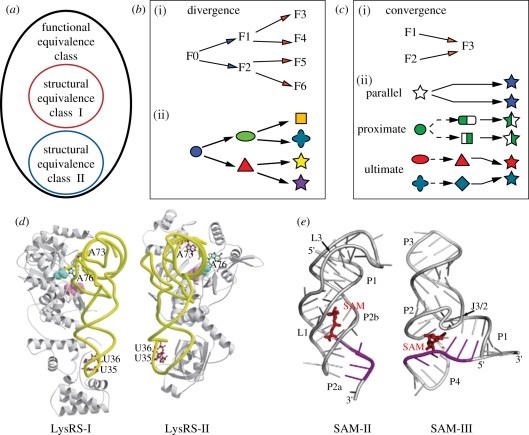Figure 3.
Evolutionary divergence, convergence and classes of functional equivalence. (a) A functional equivalence class can be formed of different structural equivalence classes. (b) By evolutionary divergence, a functional molecular system can lead to new molecules with different functionalities (i) and significant sequence and structural variations (ii). Some of these molecules can still retain the same function and belong to the same functional class. Molecular divergence implies that the divergent molecules are evolutionarily related as they have a common ancestor. (c) Two different unrelated molecules can evolve towards the same function through evolutionary convergence (i) [41]. At the molecular level (ii), one can distinguish parallel convergence (where the same molecular system in two different organisms evolves independently the same way), proximate convergence (where a molecular system that has diverged significantly in two lineages converges towards the same features) and ultimate convergence (where two different evolutionarily unrelated molecular systems converge towards the same functional features) [42]. In contrast to ultimate convergence, parallel and proximate convergences are phenomena that pertain to evolutionarily related molecules. (d–e) Classes of functional equivalence with molecules resulting from ultimate convergence. (d) Functional convergence of class I and class II Lysyl-tRNA synthetases (LysRS). These two enzyme classes have different structural topologies with different modalities of recognition of Lysyl-tRNAs (adapted from Terada et al. [43]). They are distinct structural equivalence classes that belong to the same class of functional equivalence defined by Lysyl-tRNA aminoacylation functionalities. (e) Functional convergence of class II and class III of S-adenosyl-methionine (SAM) riboswitches [44]. These two distinct structural classes have different modalities of recognizing SAM [45,46]. Figure adapted from Serganov [47].

